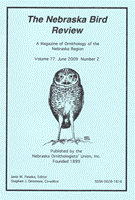Nebraska Ornithologists' Union

Nebraska Bird Review
Date of this Version
6-2022
Document Type
Article
Citation
The Nebraska Bird Review Volume 90 Number 2, June 2022, pp. 46-69
Abstract
This spring there was a large number of interesting reports generated by active field observers, particularly in the west, where our knowledge continues to be broadened in all aspects. The main takeaway this spring was the inordinate plethora of species that matched or exceeded early arrival dates listed in BONO. There were no fewer than 70 species in this category, involving most families and genera, suggesting some overall influence on migration timing. Perhaps exceptions to these early arrivals were some lingering waterfowl and gulls although terns arrived early. Fully 50 of the early arrivers were passerines, notably including nine species of flycatchers. Eye-catching high counts were 39,100 Cackling Geese in Scotts Bluff Co 3 Mar, 1920 Gadwall at the Scottsbluff WTP, 1240 Eared Grebes at Lake Minatare, and a large influx in the east of around 146 Red-necked Phalaropes at 12 different locations. Distributional changes, some continuing, some newly detected, are of interest. In Nebraska, most such changes are of eastern birds west and vice-versa, rather than apparent range expansions. Nevertheless, important examples of the latter involve westward reports of Broad-winged Hawk, Barred Owl, Red-bellied Woodpecker, and Pileated Woodpecker. Apparently increasing reports of Black-billed Magpie in the northeast hold out hope for this species there. Increasing reports of western hummingbirds formerly rare in spring suggested possible breeding Broad-tailed Hummingbirds, and there was a rare spring Calliope Hummingbird appearance. Perhaps fitting in here was a rare spring report of Hammond’s Flycatcher. Western birds east were highlighted by the extraordinary finding and photographing of two Townsend’s Warblers in the east; there are only eight spring records for the state of Townsend’s, three from the east. Less spectacular but still noteworthy were easterly records of Long-billed Curlew, Say’s Phoebe, Dark-eyed (Pink-sided) Junco, and Bullock’s Oriole. On the other hand, eastern birds west were highlighted by the 2nd Panhandle record of Kentucky Warbler, only the 4th and 5th Black-throated Green Warblers in the Panhandle, mirroring the Townsend’s Warbler sightings, and rare westward sightings of Philadelphia Vireo and Mourning Warbler. There was an interesting mix of miscellaneous sightings. A blackish American Kestrel thought to be melanistic appears not to be, but the explanation for its coloration turned out to be quite fascinating. (See article beginning on page 71.) Nests of Brown Creeper are rarely reported, but one was being monitored by Gordon Warrick at Smith Falls SP in Cherry Co. Only one White-winged Crossbill was reported, an unusual white eye-ringed Dark-eyed Junco reappeared for the second spring in a row in a Sarpy Co yard, reports of Louisiana Waterthrush in Cherry Co spring branch canyons continue to increase, and Nebraska’s 16th Painted Bunting appeared in Morrill Co. Rarities were not prominent this spring, but the 3rd state record of Black Vulture was documented in curious circumstances, and best of the others were the 2nd spring record of Gray Flycatcher, two Worm-eating Warblers, and a Golden-winged x Blue-winged (Brewster’s) Warbler. Finally, as observers are paying more attention to songs and calls, assisted by the increasing use of recording devices and Merlin to produce spectrograms, odd songs were of interest in three species: Red-eyed Vireo, Black-capped Chickadee, and Northern Parula.
Included in
Ornithology Commons, Population Biology Commons, Poultry or Avian Science Commons, Zoology Commons


Comments
Published by the Nebraska Ornithologists’ Union, Inc.